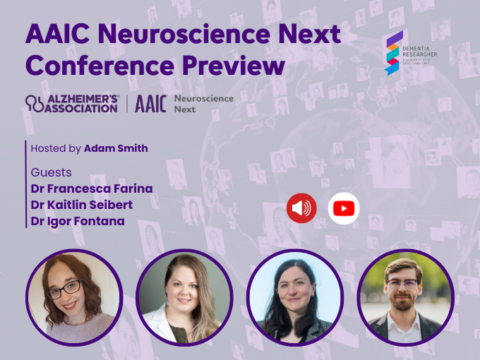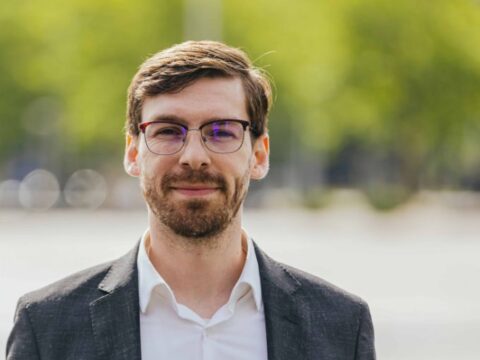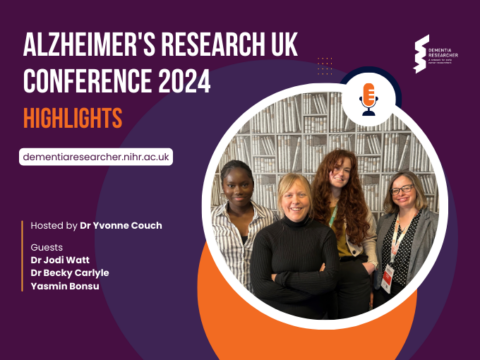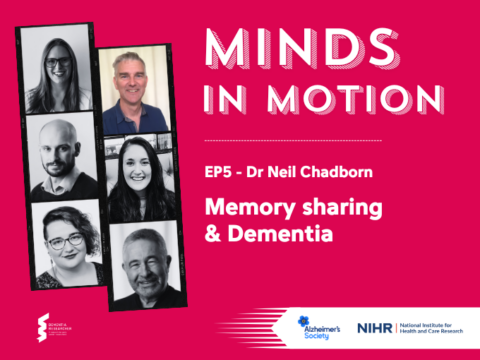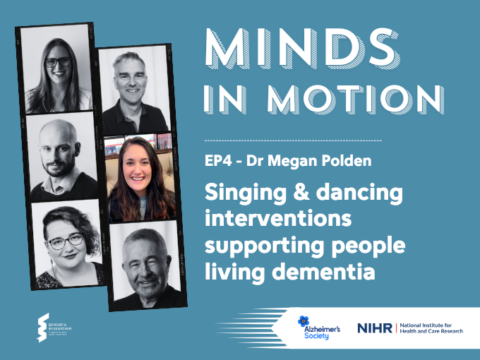A five-part special relay podcast series, where the interviewee becomes the interviewer. With five leading researchers discussing their research, their field, and the work of the Alzheimer’s Association ISTAART Professional Interest Area they represent.
Part Four – Dr Cécilia Samieri interviews Dr Sietske Sikkes
Dr Cécilia Samieri is an Epidemiologist and Senior researcher at INSERM (French National Institute for Health), in Bordeaux, France. Cécilia’s research looks at Nutritional epidemiology, lifestyle risk factors, exposome. She is representing the Nutrition and Metabolic Disorders PIA.
Dr Sietske Sikkes is a Clinical Neuropsychologist and Epidemiologist and Assistant professor at the Alzheimer Centre Amsterdam at Amsterdam University Medical Centre & VU University, Netherlands. Sietske’s is researching Neuropsychology, cognition, instrument development, psychometrics and non-pharmacological interventions. She is representing the Non-pharmacological Interventions PIA and Subjective Cognitive Decline PIA.
The Alzheimer’s Association International Society to Advance Alzheimer’s Research and Treatment (ISTAART) convenes the global Alzheimer’s and dementia science community. Members share knowledge, fuel collaboration and advance research to find more effective ways to detect, treat and prevent Alzheimer’s and other dementias. Professional Interest Areas (PIA) are an assembly of ISTAART members with common subspecialties or interests.
There are currently 25 PIA covering a wide range of interests and fields, from the Alliance of Women Alzheimer’s Researchers (AWARE) PIA to Biofluid Based Biomarkers and everything in between.
To sign-up to ISTAART and a PIA visit www.alz.org/istaart/
Adam Smith:
Hello, and thank you for listening to our ISTAART PIA Relay podcast series, brought to you by NIHR Dementia Researcher. ISTAART is a professional society and part of the Alzheimer’s Association, representing scientists, physicians, and other dementia professionals active in researching and understanding the causes and treatments of Alzheimer’s disease and other dementias.
Adam Smith:
In this five part series, we’ve asked members of ISTAART professional interest areas to take turns at interviewing their colleagues and being interviewed themselves. Confused? Don’t worry. It’ll all become clear as the week progresses. We will be releasing one of these podcasts every day in the build-up to the Alzheimer’s Association International Virtual Conference to showcase the work of ISTAART PIAs. Thank you for listening.
Dr Cécilia Samieri:
Hello, everyone, and thanks for joining us. I am Cécilia Samieri. I am a researcher in epidemiology. I work at the French National Institute for Health, which is called the INSERM, and I chair the nutrition and metabolic disorders PIA. Today, I am delighted and very happy to be talking with Dr. Sietske Sikkes. Hello, Sietske. Can I start by asking you maybe to introduce yourself, and tell us which PIA you are involved with?
Dr Sietske Sikkes:
Yes, of course. And congratulations on pronouncing my name so well, because it’s the most difficult name ever. It’s a typical Dutch name, but you did very, very well. So I’m Sietske. I am an assistant professor at the Alzheimer’s Centre, Amsterdam, of the Amsterdam University Medical Centres and the Department of Clinical Neuropsychology of the VU university. I have a background in clinical neuropsychology and in epidemiology, and I’m involved in two PIAs actually. I chair the PIA for the non-pharmacological interventions, and I’m also involved in the PIA for subjective cognitive decline, where I’m the chair elect.
Dr Cécilia Samieri:
Great. So, I’d say you have a very rich background. You moved a little bit for postdoctoral position in Paris actually, with people that I know. And then to Boston, to Harvard medical school, and I say as well that you were very much interested in cross-cultural differences in terms of neuropsychology. So I was wondering how this very rich experience informs, or change or modify the way were thinking about cross cultural differences in your fields?
Dr Sietske Sikkes:
Yeah, that certainly has enriched my experience of how to look at cross-cultural differences. Because in my research project, this was actually my PhD project, where I looked into the measurement of everyday functioning. And during my first presentation at AAIC, I presented the work we had been doing in developing a new measurement tool for everyday functioning. And I was approached by someone from Thailand, who said, “Oh, can we actually use your instruments?” And I thought, well, that’s… Of course the everyday activities differ very much from what we see in our population. And ever since I’ve been intrigued by cross-cultural differences and how we can apply measurement tools across cultures. So for my postdoctoral fellowship, I went indeed to Paris and to Australia to study cross-cultural differences.
Dr Sietske Sikkes:
And I would have expected to some degree that the difference, for example, with Australia would be much bigger than with France. I thought well, France, is France. But actually I observed that the cross-cultural differences were very big between the Netherlands and France. And I experienced that also because I lived there for a while and yeah, I thought it was very informative also because we started out with doing a translation of our tool. So it’s a questionnaire and we did a simple translation. And then when I arrived with my translation in Paris, people were like, “I don’t understand what it says.” And then it turned out that the translator wasn’t actually from France, but from Belgium. And there was a lot of Belgian France in the translation. So that was very… Then I thought, “Ah, it’s never as easy as it seems.”
Dr Sietske Sikkes:
So ever since, when people talk about translation, I’m always like, “Well, beware.” There’s a lot of more work involved than you think.
Dr Cécilia Samieri:
That’s really great. It’s so interesting. Can you tell us a little bit more about your research, because you have been doing a lot also in non-pharmacological intervention as well. So I would be interested to know more about that part as well.
Dr Sietske Sikkes:
Yeah. So I did maybe to start with the non-pharmacological interventions, that was actually research that I have been doing specifically focusing on lifestyle and the prevention of Alzheimer’s disease and then for people who experienced memory complaints. And we just completed a big project where we looked specifically at how to inform people about lifestyle and lifestyle changes. Because when we think about lifestyle and prevention of Alzheimer’s disease, it isn’t a simple solution. It isn’t a simple six week intervention and then you’re done, then your Alzheimer’s risk is gone.
Dr Sietske Sikkes:
It doesn’t work like that. At least that’s what’s we assume. And that’s obviously your research also, where lies the time window, and when do you have to intervene and for how long. But my idea would be that with lifestyle changes, it would be a very… You need to accomplish structural changes. So we focused in this project on whether people are interested in information about lifestyle and the brain and how we can present that information. And what I thought the most striking findings were actually that people were very interested in learning about lifestyle and the brain. But that they also didn’t know where to look. So they would just Google information and they would have the strangest associations that you find on Google. And they were like, “Yeah, I probably these resources are not trustworthy, but I don’t really know where to look.”
Dr Sietske Sikkes:
So we found that on the one hand. So that’s very promising that people want to know about the information, and they’re looking for that kind of information. But on the other hand, we found that these interventions need to be tailored. They need to be personalised. Because it can also have the opposite effect. If you tell someone who is completely not physical active, and you give that person the advice to go for a run, then that’s too far out. So that doesn’t work and can actually have the opposite effect of not wanting to have to do anything with the intervention at all. So the information needs to be personalised in order to have the effects. And I think that these were the main findings from that project focusing on prevention.
Dr Cécilia Samieri:
All right. And by the way, you are thinking about the finger study applied to your country? Or is that a different project?
Dr Sietske Sikkes:
That’s a different project. And actually the Dutch part of the finger study, we’re currently in the process of setting that up. And I’m also involved in that study, but this was specifically a study focusing on people who present with memory complaints. So the people with subjective cognitive decline. So, I work in the Alzheimer’s Centre, which is a memory clinic. And there we see about a third of the patients that we see have memory complaints, but their cognitive performance is still completely normal. And from those people, we really got the question, “Okay, but what can I do from a lifestyle perspective?” So these people we know have a need for information. And the finger study is of course more aimed at the general public, but this was specifically that population from which we know that they have a need for information. And also it felt like if you… That you really want to offer them something as a clinician that you do not want to say, “Yeah, you can do healthy lifestyle stuff” but you really would like to give them more concrete advice.
Dr Cécilia Samieri:
So in France, we have that issue. So clinicians told me that in memory clinics, there are less and less early [inaudible 00:10:38] patients. People go to the clinics really too late. And so it’s quite difficult for people to set up early intervention, early trials, because the patients just don’t go to the memory clinics. Maybe it’s very different in your country because it’s very country specific, the way that it is organised, but what is your feeling about that?
Dr Sietske Sikkes:
So the trend that we observe is actually that people come earlier and earlier. So it might be a country specific trend.
Dr Cécilia Samieri:
Maybe the physicians are well-informed in your country and just tell the people to go to the specialty centre.
Dr Sietske Sikkes:
Yeah. So I think that is indeed the case. It’s also, our a national patient organisation works a lot on getting people informed. So it could be the case that that’s a difference, but I would think that in France, you would have the same.
Dr Cécilia Samieri:
People tell that’s not the case. People say that the physicians in France don’t really believe that. Because we have no treatments, they are not really willing to tell people to go to the memory clinics, to get a diagnosis. They would tend to say, “Okay, there is nothing to do.” Although we all know that it’s not the case. There is a lot to do in prevention, but it’s maybe a control thing as well. I think it’s an issue. Of course, La Salpêtrière, where you worked, has got a really great memory clinic, with a lot of patients. But generally, I think, in the whole country it’s more complicated.
Dr Sietske Sikkes:
Yeah. So it is a general awareness issue of seeking help when it’s still… Well, according to the recent insights it’s of course the earlier you are, the better. So it is awareness of being able to do something. And I think that is indeed a shift in awareness that is necessary.
Dr Cécilia Samieri:
So maybe we can talk a little bit about the PIA now, because it’s very important. So how does the work of your PIA support your field? So you’re involved in two different PIAs. So what can you tell us about that?
Dr Sietske Sikkes:
Yeah, I think the PIA really supports actually a lot of the research. So for the non-pharmacological interventions PIA, during the scientific session, but also during the business meeting, I think this was two years ago. We had an extensive discussion about what non-pharmacological interventions actually are because non-pharmacological is just defining something by what it is not. So we had this whole existential crisis of what are non-pharmacological interventions. And based on that discussion, we gathered experts and really asked them about their interventions and to structure their interventions in a similar way, according to a framework. And then we also ask them to give an overview of their field based on really systematic evaluations. And based on that, together, we wrote a position paper and actually people from the nutrition PIA were involved as well.
Dr Sietske Sikkes:
Martha Clare Morris was very involved in setting up the position paper. And then we’ve also… It’s currently still under review, but we’ve decided to dedicate the paper to her memory because she was very active in setting it up. And so this was really a cross PIA collaboration on really trying to structure the non-pharmacological interventions, and to answer the question on what it is and what it characterises. And I think that it will be a very important paper. And I think that is one way how a discussion in the PIA led to an, I think, important paper. But another thing is for the non-pharmacological interventions PIA, what we had was, we have this specific working group that is focused on methodological quality of non-pharmacological interventions. And that’s also something that we found out when trying to characterise the interventions is that you have a lot of different interventions, but that the methodological quality differs very much.
Dr Sietske Sikkes:
And it varies, and it’s very difficult to evaluate the evidence when the level of evidence isn’t always comparable. So we have a working group, the [cider 00:16:15] working group that focuses on the methodological quality, and have also published the cocktail tool. And that’s a website where you can evaluate the level of evidence for non-pharmacological interventions. So these are really two efforts that lead to improving the quality of non-pharmacological interventions, and the access to information about that.
Dr Sietske Sikkes:
And with regards to the subjective cognitive decline PIA, that PIA was well, actually the research was always the main focus of the PIA. So the PIA formed and immediately worked on position papers, but in the PIA, there, a lot of researchers are getting connected throughout the PIA and also share data. We have quite a lot of publications coming out from the PIA where people used data sets across countries. So that is really very much a research focused PIA. And I think that in both cases, the PIA is really helping to propel the research and the research quality and connecting people.
Dr Cécilia Samieri:
That’s really interesting to see because you have two different PIA and the level of organisation and development is quite different between both. So according to the group of people who gather, and according to the topic, you have really different kinds of discussions, insights. It’s really great. So how could early career researchers join your PIA?
Dr Sietske Sikkes:
Well, they can join the PIA of course, but if they want to be actively involved, we always are very keen on having young people involved in the PIA. And here I can really recommend people to reach out. So for example, last year we had one of the junior presenters in our PIA reach out and say, “Hey, can I get involved?” And now she’s a student representative in our PIA. So I think that’s really worked. So we have two student representatives in our PIA. And what I like is that they come up with the creative ideas on how to involve people in our PIA. So this year we have, for example, student awards and with the subjective cognitive decline PIA we had a dinner organised last year and also drinks after PIA day, really to connect people.
Dr Sietske Sikkes:
And yeah, I think it’s one thing to be involved in the PIA, I think a lot of PIAs are really happy if someone reaches out and says, “I’d like to be involved.” I don’t know about you, but I am always very happy when I hear people say that, but it’s also a way to connect to other young researchers. And from my own experience, as a young researcher, was actually during my first AAIC, I went to a PIA meeting. And because AAIC is such a big conference, it was really nice to meet some people that were involved in the same field of research that I was. So I think it’s really a way to find your-
Dr Cécilia Samieri:
Yeah. And it’s a good way to find your independence as a researcher.
Dr Sietske Sikkes:
Yeah, exactly. Yeah.
Dr Cécilia Samieri:
And what are your plans in the two different PIA for the next year? Do you have some very specific goals?
Dr Sietske Sikkes:
I think we have some specific goals for this AAIC. So here we have a scientific session, which will be available as a prerecording, but we’ll also have our PIA chats and on PIA day, we’ll have a live Q&A session. And also then we’ll have the announcement of our student award winner. So that will be very exciting. That will be August 12th at 8:00 AM Central Time. And for the SED PIA we will also have a live panel discussion on August 5th, 8:00 AM.
Dr Sietske Sikkes:
And for the coming year, the very specific plans. I think what we will do this year again, is to continue on our cross-PIA collaborations, both for the non-pharmacological interventions and for the subjective cognitive decline PIA, we’ve hosted webinars together with the diversity PIA and in both cases, that was a big success. So for the SED PIA, we also have a featured research session focused on SED and diversity issues. For the non-pharmacological interventions PIA we’d also like to organize a featured research session for next year. And we plan to have some open membership calls where people can join the calls on our committee. And we’ve started some webinar series of which the diversity was the first one. And we’ll continue that probably as long as we’re still stuck at home. Webinars are suddenly a very attractive means to an end.
Dr Cécilia Samieri:
Wow. That’s an amazing program. Well thank you so much, Sietske. It was really great to talk to you. It is time to end today podcast recording, but before we go, I do have a final question for you. What advice would you give to any aspiring scientists out there who are thinking of looking into dementia?
Dr Sietske Sikkes:
I found this the most difficult question ever. What I would advise, and I can only advise something on how I personally work. And that is to reach out to people, because I think the dementia research field is a very friendly research field and people are very keen on helping each other and really working together on this big problem that we all really want to solve. So I would say if you want to know things and learn things, reach out to people and connect with them. And that is because I think that you do science together, and together we can solve this.
Dr Cécilia Samieri:
Great. Thank you so much, Sietske, for taking time to join us today. Goodbye.
Adam Smith:
Thank you so much for listening. You can find details on profiles on today’s panellists and information on how to become involved in ISTAART on our website www.dementiaresearcher.nihr.ac.uk, and also at www.alz.org/ISTAART, we’ll be back tomorrow with the next recording in our ISTAART PIA Relay podcast series. Finally, please remember to subscribe, like, and review our podcast on iTunes, Spotify, and all the other places where you find your podcasts. Thank you.
END
Like what you hear? Please review, like, and share our podcast – and don’t forget to subscribe to ensure you never miss an episode.
If you would like to share your own experiences or discuss your research in a blog or on a podcast, drop us a line to adam.smith@nihr.ac.uk or find us on twitter @dem_researcher
You can find our podcast on iTunes, SoundCloud and Spotify and where ever you get your podcasts.
Finally, the views and opinions expressed by guests in this podcast represent those of the guests and do not necessarily reflect those of NIHR Dementia Researchers, PIA membership, ISTAART or the Alzheimer’s Association.

 Print This Post
Print This Post
